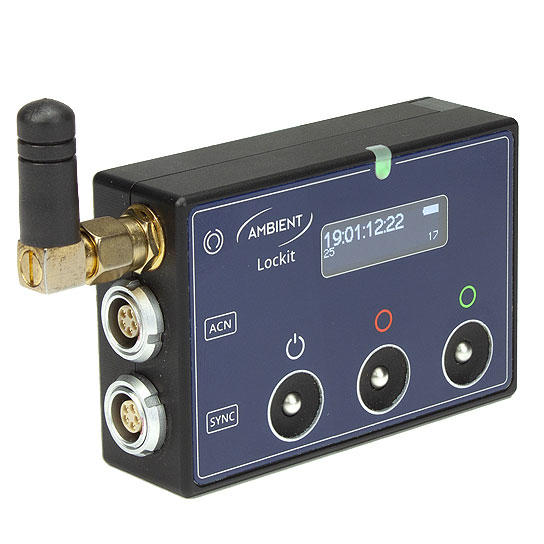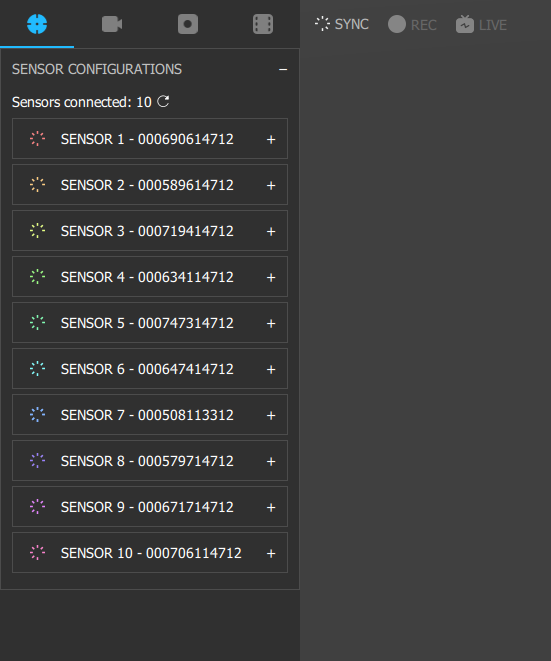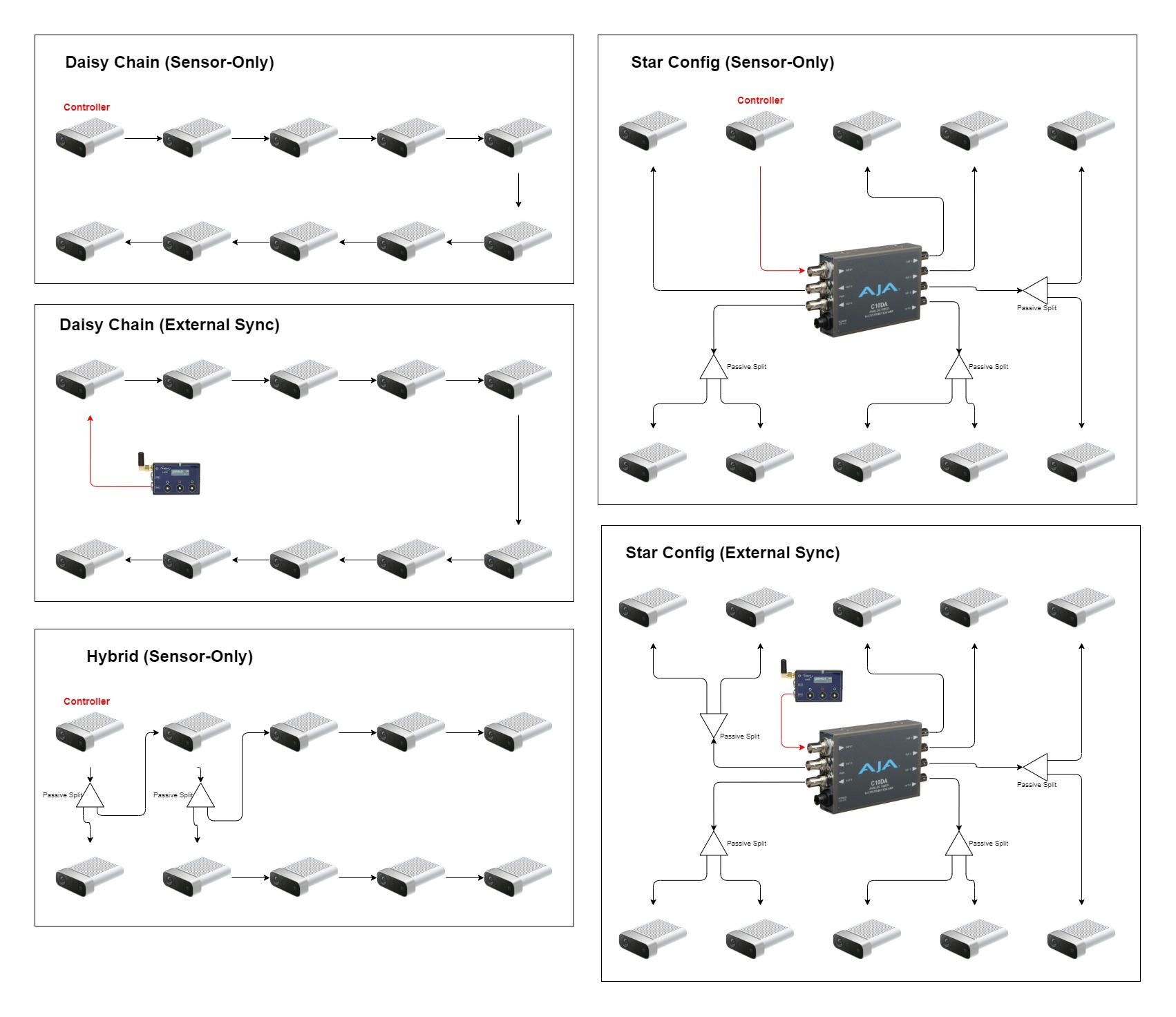Azure Kinect DK Sensor sync
It's necessary to synchronize all of your sensors to each other to ensure that the data from each sensor aligns. This is accomplished by connecting all of the sensors with sync cables. Refer to our hardware requirements guide on how to select the right sync cables.
Remove Azure Kinect CoverTo synchronize the sensors, expose the sync ports on the back of your Azure Kinects by removing the two screws in the rear of the device (a Torx wrench is included with the Kinect), and slipping off the white plastic casing.
In this page
Daisy-Chain (Sensors-Only) →
External sync generator + daisy-chain (experimental) →
Star-configuration and hybrid topologies →
Next steps →\
Daisy-chain (sensors-only)

This configuration uses one of your sensors as the generator, which provides a sync reference signal to each of the other sensors by looping through each sensor's sync ports.
Select one sensor to be your primary or master sensor. This sensor will have nothing plugged into its Sync In port.
Connect a cable from the primary sensor's Sync Out port to the Sync In port of the next sensor. Repeat this for every sensor in the chain, until you reach the last sensor, which will have nothing plugged into its Sync Out port.

Once the hardware is setup, synchronization will occur automatically within Depthkit. This can be confirmed by checking the sync indicators once you begin streaming.
Move around in front of the sensors and observe the 3D viewport to ensure none of the sensors are lagging behind the others.
Sensor sync troubleshooting
See the Synchronization Issues page for troubleshooting synchronization.
The above icons will appear next to your sensors. A proper configuration will report one control sensor, and all other sensors a subordinates with a dot.
External sync generator + daisy chain (experimental)

Sensor sync can be driven from an external source. This is useful for ensuring that Depthkit recordings do not drift from other types of simultaneous recordings, like audio or Depthkit Cinema cameras.
An external sync generator must conform to the characteristics listed in Microsoft's documentation.
One device which can provide a compatible signal is Ambient Recording's ACN-CL Lockit, which is capable of outputting a 30.0fps Pulse-per-Frame sync signal. (The required custom cable connected to the Sync Out Lemo Port, Pin 3 is sold separately - See the pinout diagram on Page 8 of the Lockit manual) This sync generator can be jammed or locked to other sync generators and recording devices to ensure your recordings remain temporally locked.
To make use of this, set up your sensors in daisy-chain configuration as described above. Connect the external sync generator to the 'Sync In' port on your primary sensor.
Locking Multiple Systems TogetherA sync generator like the Ambient Lockit generator is calibrated to precisely keep time, but if you want to guarantee that your Depthkit captures record in perfect lockstep with other systems, you'll need to bridge the sync generator to the other systems as well. This is easily done by simultaneously connecting the Lockit's Sync Out Lemo Port, Pin 3 to the sensors, and the Sync Out Lemo Port, Pin 4 to an audio recorder's Word Clock input or a Cinema Camera's genlock input. This requires a custom-wired Lemo cable.
When starting up your sensors in the Multicam Calibration/Streaming context:
-
Turn off the external sync generator, or momentarily disconnect the generator from the sensor.
-
Start Depthkit's Multicam Calibration/Streamings mode. Wait a few seconds for the spinning indicators to appear next to the sensors (the console to display
Waiting for sync...for each of the sensors you have plugged in).

-
Turn the sync generator back on, or reconnect it to the sensor. The sensors will start streaming, and you'll see a live pointcloud in the 3D viewport.
-
In the Sensor Configuration pane, confirm that each of the sensors report a Sync Mode of
Multicam Subodinate. Move around in front of the sensors and observe the 3D viewport to ensure none of the sensors are lagging behind the others.
Star-configuration and hybrid topologies

Depthkit supports many types of sync cable configurations, including star configurations which help keep cables more organized.
Star-configuration can either use one of the sensors as the sync source or use an external sync generator.
If the signal from one source is only being split to two destinations, you can use passive 1/8" (3.5mm) TRS Y-splitter cables.
If splitting the sync signal from one source to more than two destinations, a distribution amplifier (DA) is required to maintain the signal strength. One device which works for this purpose is the AJA C10DA Analog Video Distribution Amplifier. The signal needs to be adapted from the 1/8" (3.5mm) Tip Sleeve (TS) connectors on the sensors to BNC connectors on the C10DA with an adapter cable.
Next steps
Once your Azure Kinect sensors are setup to be in sync with one another, proceed to the Calibration guide.
Updated 9 months ago
